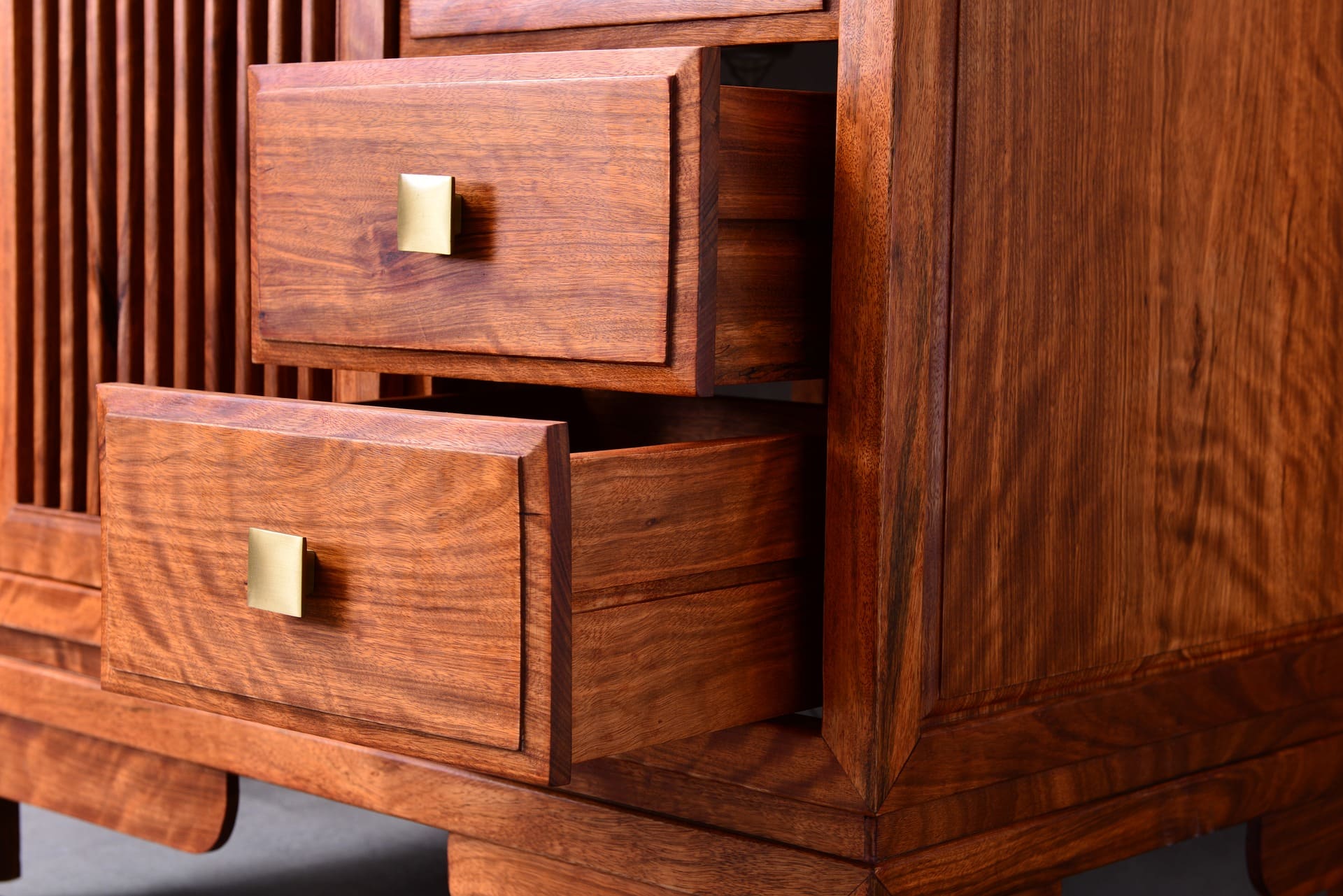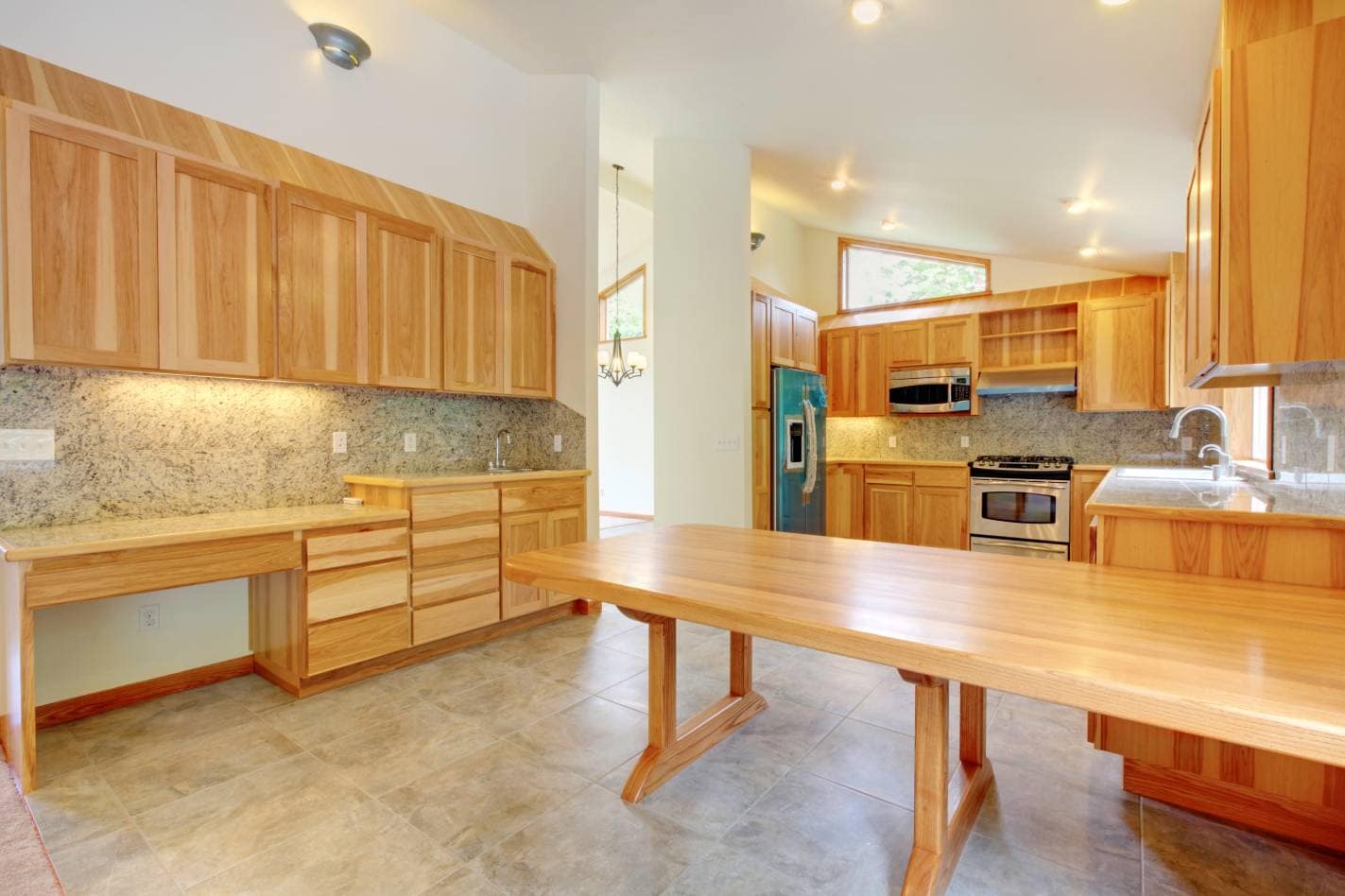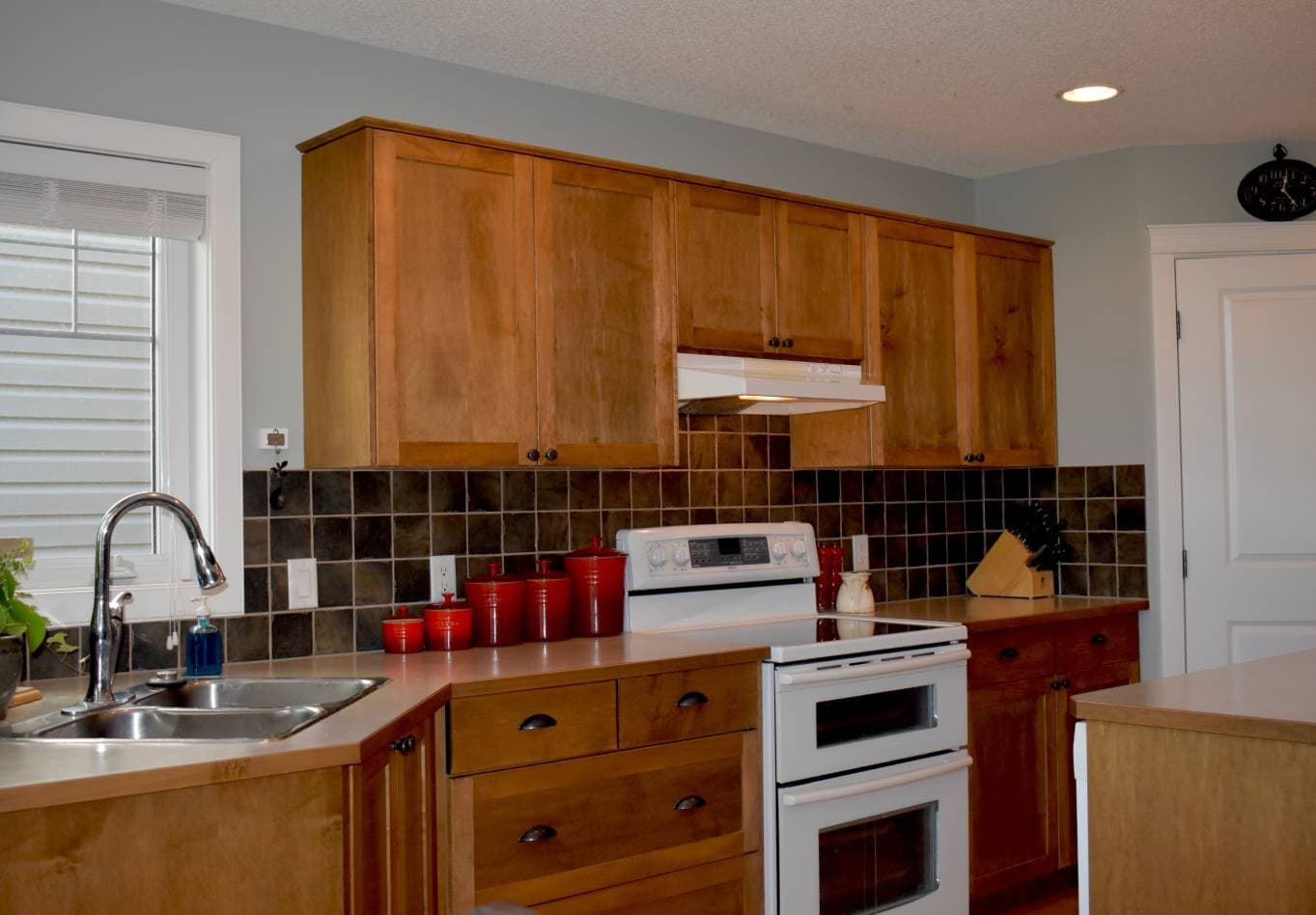What Is the Best Wood for Cabinets? (With Pictures)
-
Pete Ortiz
- Last updated:

Cabinets—they come in all shapes, sizes, and colors. Most importantly, they are crafted from different wood materials. Some experts swear by maple, while others claim nothing can compare to birch and beech. So, how do you make the right choice here? What does the best wood for kitchen cabinets look like? We’ve got your back on this one! After weeks of meticulous, hands-on testing, we made a list of top-14 woods for cabinets.
The list includes ash, hickory, oak, maple, alder, and birch, to name a few. All these wood types have different hardness ratings, density, and resistance to environmental factors. Let’s take a closer look at each wood type and see which ones offer the right mix of aesthetics, ease of use, reliability, and affordability.
The 14 Best Woods for Cabinets
1. White Oak

| Wood Type | Hardwood |
| Hardness/Denting Resistance | 1,360 lbf |
| Wood Density | 56.2 lb/ft3 |
| Water Resistance | High |
| Flexibility | Moderate/High |
White oak is one of the most used natural woods in furniture. It takes very little effort to stain/finish or paint. More importantly, it boasts above-average hardness and density, which equals an extended lifespan. As for the graining, it is coarse, uneven, and will show through stain—if you’re going for an all-natural look, keep this in mind.
Another big pro of white oak is it is highly resistant to not only water but also rot and UV rays (sunlight). Flexibility will be a part of the deal as well. Despite the impressive hardness, this wood is easy to work with. White oak isn’t particularly cheap, though.
2. Red Oak
| Wood Type | Hardwood |
| Hardness/Denting Resistance | 1,290 lbf |
| Wood Density | 48.7 lb/ft3 |
| Water Resistance | Low |
| Flexibility | Moderate |
What’s the difference between white and red oak—that’s the big question here. Well, red oak has a lighter, more natural texture. The wood grain pattern is stronger, too. If you’ve got kids and pets in the house, red oak will be a more reasonable pick, as it does a better job of concealing tiny dents and scratches. In addition, it’s cheaper than white oak and looks great on kitchen cabinets.
On the downside, red oak isn’t at all water-resistant (so, not a very good choice for a humid area) and takes more effort to work with. Furthermore, the hardness rating is a bit lower, but the difference isn’t that big.
3. Maple
| Wood Type | Hardwood |
| Hardness/Denting Resistance | 1450 lbf |
| Wood Density | 47.1 lb/ft3 |
| Water Resistance | High |
| Flexibility | Moderate |
The best thing about maple is that it works great with any stain but still maintains the lovely natural-wood look. You can try painting or varnishing it until you get that perfect vibe for the kitchen. This tree mostly grows in Asia, which is why maple cabinets produced in China are moderately-priced, despite this being an expensive hardwood. Maple is a hard and relatively dense species with high water resistance and ok workability.
As for the color, it ranges from creamy to white and fits a wide range of kitchen designs, especially traditional styles. Finally, maple is highly resistant to scratches, dents, and wear.
4. American Cherry

| Wood Type | Hardwood |
| Hardness/Denting Resistance | 995 lbf |
| Wood Density | 34 lb/ft3 |
| Water Resistance | Very High |
| Flexibility | Very High |
There are many different cherry species on the planet, but American cherry is the one that suits cabinets best. Its hardness and density ratings aren’t off the charts, yet this is still a long-lasting and reliable wood type. The one thing that makes it stand out is the flexibility. American cherry is very easy to cut, shape, finish, or paint. Moreover, it easily handles even the highest humidity levels.
Next, the deep and rich red/brown color, along with the wavy grain, is perfect for kitchen and living room cabinets. The only downside is cherry is somewhat expensive, but it also has that premium, timeless look.
5. Ash
| Wood Type | Hardwood |
| Hardness/Denting Resistance | 1,320 lbf |
| Wood Density | 53 lb/ft3 |
| Water Resistance | Low/Moderate |
| Flexibility | Moderate |
If you’re going for a natural, light theme for the cabinets, ash might be exactly what you need. It is hard, sturdy, dense, and doesn’t take years of experience to work with. Ash stains well and looks marvelous, both treated and natural. Now, what makes it a really attractive pick is the affordable price. It grows in the States and is a very popular choice in American households.
It’s not particularly fancy but does look great. As for the cons, resistance to water, decay, and scratches is average at best.
6. Mahogany

| Wood Type | Hardwood |
| Hardness/Denting Resistance | 900 lbf |
| Wood Density | 56 lb/ft3 |
| Water Resistance | High |
| Flexibility | Very High |
What makes mahogany a worthy pick for kitchen cabinets? First, it’s got a dark, deep, and elegant tone (reddish-brown). Second, it is water and decay-resistant, stains well, and can be painted over. It’s safe to say that mahogany is one of the best-looking wood species out there. It’s durable, tough, and has an above-average density rating. Unfortunately, it’s also very expensive; it costs more than oak, maple, and walnut.
Ultimately, it depends on your budget for the cabinets. If you’re ready to invest a bit extra for top-notch quality, mahogany will be money well spent. If not, go for something cheaper, like ash or red oak.
7. Hickory

| Wood Type | Hardwood |
| Hardness/Denting Resistance | 1,820 lbf |
| Wood Density | 38.7 lb/ft3 |
| Water Resistance | Low |
| Flexibility | Very Low |
Did you know that hickory is one of the hardest wood species in the world? Yes, that’s true, and it means two things: hickory cabinets will last for many years (if not decades) with low maintenance. However, this wood is also hard to work with. To stain it, you’ll have to sand the surface with heavy-grip sandpaper. Furthermore, resistance to humidity is well below average.
On the bright side, hickory has a bright, uplifting brown color and will go perfectly with a rural slash rustic theme. The thing that makes this hardwood popular is the affordable price.
8. Poplar
| Wood Type | Hardwood |
| Hardness/Denting Resistance | 540 lbf |
| Wood Density | 31 lb/ft3 |
| Water Resistance | Moderate |
| Flexibility | Very High |
Is poplar even hardwood? That’s what most people think when they check its hardness and density. Well, yes, it is hardwood, but a soft one. As you’ve probably already guessed, low strength means high flexibility. Poplar is easy to stain or paint and has a somewhat “boring” texture that’s very easy to match to a long list of styles.
This is one of the least expensive options on the market, by the way. So, if you’re looking for a low-priced, flexible, and versatile wood for your kitchen cabinets, poplar might be the right pick. It won’t last for decades, but as a quick and cheap solution, you can’t go wrong with it.
9. Birch

| Wood Type | Hardwood |
| Hardness/Denting Resistance | 1260 lbf |
| Wood Density | 38.1 lb/ft3 |
| Water Resistance | Low |
| Flexibility | Moderate/High |
Darker than maple and stronger than most hardwoods on the market, birch is a splendid choice for kitchen cabinets. With the right finish, it will look almost as lush and expensive as the top-tier wood species. The biggest downside of birch is its weakness against humidity, decay, and rot: swelling and warping tend to be an issue with this hardwood.
And if you accidentally scratch or dent it, that will be a bit challenging to hide. Still, as a low-priced and flexible material for cabinets, birch is a bargain.
10. Beech
| Wood Type | Hardwood |
| Hardness/Denting Resistance | 1300 lbf |
| Wood Density | 56 lb/ft3 |
| Water Resistance | Very Low |
| Flexibility | High |
Beech has a lot in common with birch. Just like its “big brother”, it features a straight-ish, light-brown grain and a decent hardness rating. The pattern is a bit different, however, and it’s denser than birch. Beech is an even cheaper alternative to oak, maple, and cherry and stains well, especially if you’re going for lighter tones. Woodworkers, in turn, appreciate its flexible nature; beech is very easy to cut and shape to your liking.
Pale in color, beech fits traditional kitchens best but is also compatible with modern, vintage, and futuristic designs.
11. Walnut

| Wood Type | Hardwood |
| Hardness/Denting Resistance | 1,010 lbf |
| Wood Density | 38.1 lb/ft3 |
| Water Resistance | High |
| Flexibility | High |
Walnut is not cheap. It does grow in the US and Canada, though, and is widely available. With a slightly above average hardness rating and decent density, it doesn’t scratch, dent, or warp easily. However, its biggest appeal is the lush, sleek brown color that goes incredibly well with modern-day kitchen hardware and appliances.
This wood is available in dozens of different grains and hues. To bring out the grain and make it shine through, we recommend using a light finish/coating.
12. Pine
| Wood Type | Softwood |
| Hardness/Denting Resistance | 1225 lbf |
| Wood Density | 31 lb/ft3 |
| Water Resistance | Moderate/High |
| Flexibility | High |
Pine is a softwood species, not a hardwood. So, does that mean it is brittle, hard to maintain, and warps easily? Not at all! Pine has an incredibly high hardness rating for softwood (1225) and can withstand average to high humidity levels. It is a flexible wood type and has a “royal” yellow hue with a rural/rustic vibe, despite the low price.
Yes, pine is one of the most affordable woods for cabinets. Sadly, there is one downside: it easily scratches and dents. But, if you’re careful, this shouldn’t be that big of a problem.
13. Douglas Fir
| Wood Type | Softwood |
| Hardness/Denting Resistance | 660 lbf |
| Wood Density | 33.1 lb/ft3 |
| Water Resistance | Low/Moderate |
| Flexibility | Moderate |
An evergreen conifer, Douglas fir is a softwood species, like pine. It’s not very hard, sturdy, or dense. Furthermore, it’s not at all resistant to scratches. You might still want to keep it on the list, though, because this wood is cheap, flexible, and has a “universal” design that gives the kitchen a clean, smooth look.
The pale, rosy-colored tone works especially well on cabinet doors. We wouldn’t recommend using this wood in humid areas, however.
14. Alder
| Wood Type | Hardwood |
| Hardness/Denting Resistance | 590 lbf |
| Wood Density | 42 lb/ft3 |
| Water Resistance | Moderate/High |
| Flexibility | Very High |
Alder is a hardwood species, but it’s not at all hard. That makes it a highly flexible option, which is great news if you’re a professional carpenter and want to manufacture the new cabinets for your kitchen manually. Low strength also means a shorter lifespan, of course. Alder looks a lot like cherry and comes at a much lower price.
Besides, it has a softer hue that gets lighter as it ages. Traditional, transitional, rustic, and farmhouse—alder will fit all these styles like a glove. You can go with knotty alder as well. It’s not extremely popular yet but it is just as useful.
How to Pick the Right Wood for Kitchen Cabinets?
What’s the difference between paint and stain? Is hardwood the best option for cabinets, or not? Does flexibility play a big role here? Read on, and you’ll find answers to all these questions in our detailed guide.
Hardwood or Softwood?
For most homeowners, the short answer will be hardwood, of course. It’s much sturdier and has a superior lifespan compared to softwood. Plus, it requires very little maintenance. Hardwood is pretty heavy, though, and usually costs more. Softwood, in contrast, has a shorter service life, but it is much cheaper. In addition, softwood is more flexible and requires less force and skills to work with.
Hardness and Density
No matter how expensive a certain wood species is, if it has a below-average hardness rating, it won’t stand the test of time. The higher the hardness rating, the more resistant they will be to wear and dent. Density is also important. It defines how stiff and strong the material is.
Environmental factors like humidity, atmospheric pressure, and temperature fluctuations have a huge impact on wood. Over time, they make it warp and fall apart. Moisture is the biggest “enemy” of any wood type. So, check the water and decay resistance before investing in any wood species.

Flexibility/Workability
You should only worry about flexibility if you’re planning on carving out the cabinets manually. Lack of workability is one of the biggest downsides of hardwood, while softwood is easier to cut and shape. In most cases, the higher the hardness-density, the lower the flexibility, but this rule doesn’t always apply.
Stained or Painted?
In many ways, it depends on your personal preferences. Some folks love the natural look of different wood species. If you’re just like that, staining will be the right choice. It’s cheaper than paint, easier to apply, and perfect for bringing the natural wood grain forward. On top of that, you won’t have to prime the wood before applying it. In contrast to paint, stain absorbs into the wood instead of spreading over the surface. However, this can also be a con.
Depending on how absorbent the surface is, you might need to add multiple layers/coats of stain for it to “stick”. Paint also benefits from an extra layer or two. But, as mentioned, it doesn’t seep into the wood but rather stays on top of it. Plus, with paint, you have lots of different colors, mattes, and sheens to pick from. Paint is expensive, though, and doesn’t look great on non-primed surfaces. Furthermore, it tends to peel.
 Conclusion
Conclusion
The best thing about wood is that you are free to combine different types/species and finishes to create the right vibe. So, if you’re buying a new home or just remodeling the kitchen, make sure to pick the perfect wood for the cabinets. As we learned today, oak, maple, walnut, and hickory are some of the strongest and most durable options.
They do cost a lot, but if you’re looking for premium wood for your cabinets, these will be a reasonable investment. And then we have birch, pine, and beech that come at a more reasonable price. Take your time with our list, pay extra attention to the metrics, and rock those new wood cabinets!
Featured Image Credit: timltv, Shutterstock
Contents



